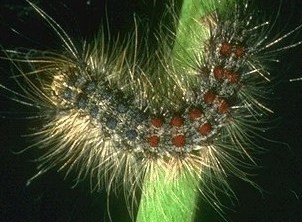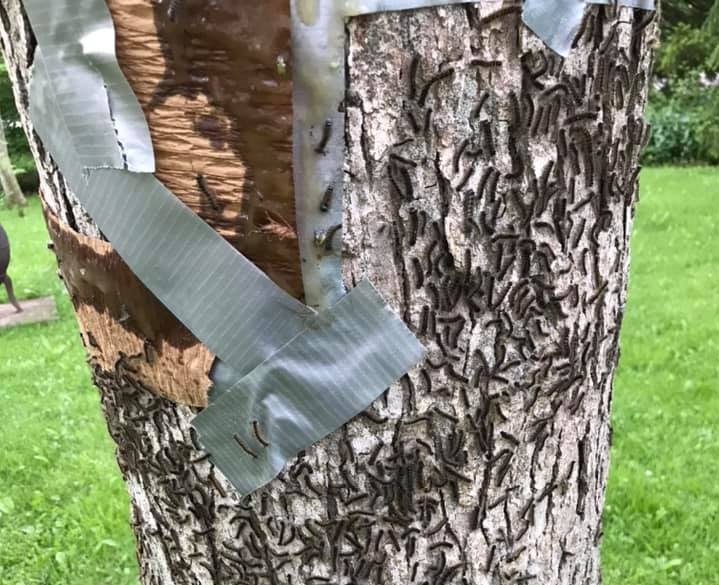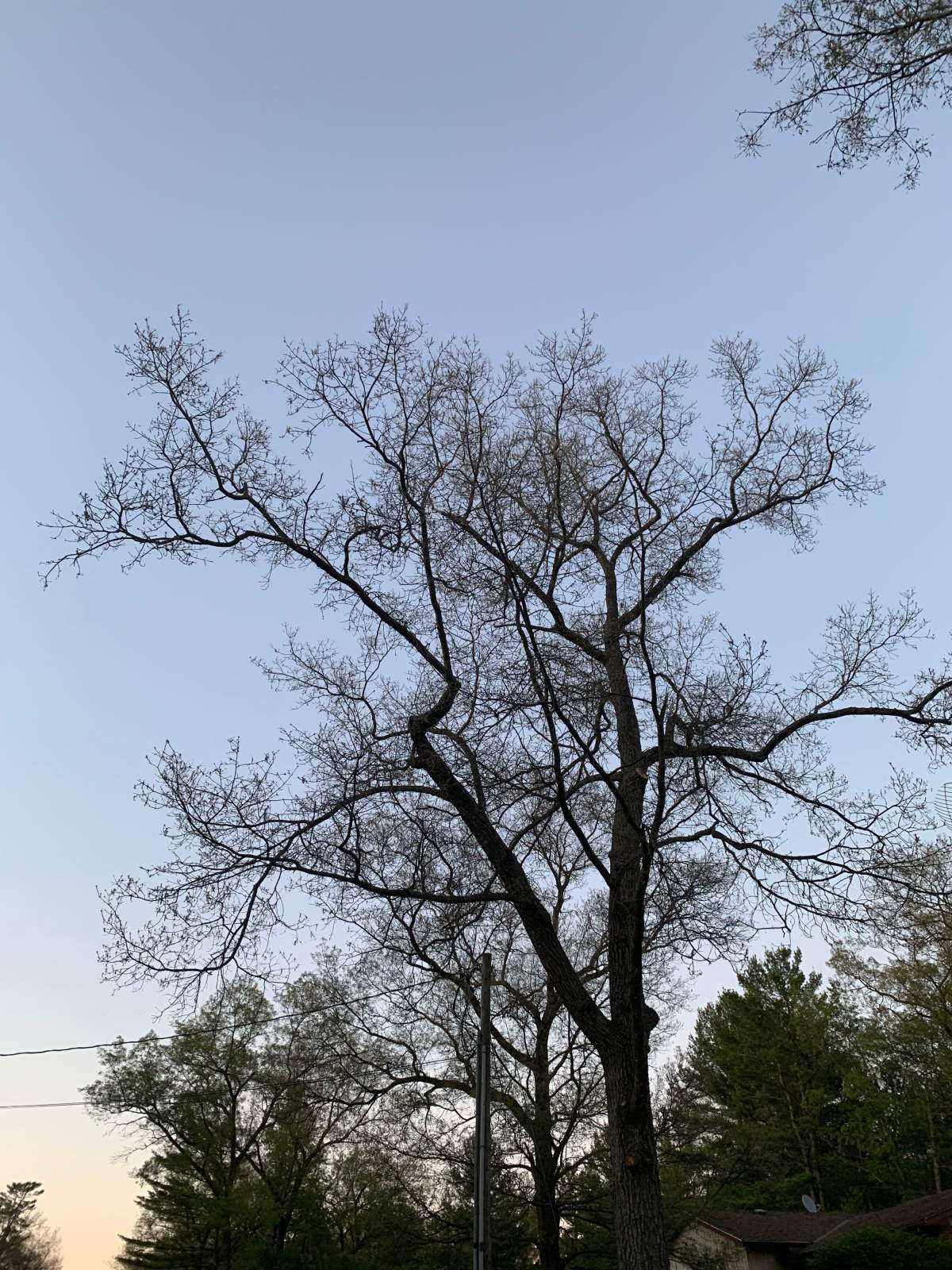An explosive outbreak of European gypsy moth caterpillars across southwestern Ontario has many residents of Port Franks in Lambton Shores off Lake Huron frustrated with what they see as a lack of action from the municipality.

While many other municipalities in Ontario — including Sarnia, Pelham, Hamilton, and Toronto — have undertaken aerial spraying programs to combat the invasive species, the mayor of Lambton Shores has so far suggested that property owners should address the pest as they see fit.
“I would like to point out that I have talked with a number of residents that feel ‘someone needs to do something’ to control the pest, and others that are equally committed to let nature run its course,” Mayor Bill Weber wrote in a COVID-19 municipal update dated June 10.
“Please remember that these are trying times for all of us, and as neighbours we need to respect the viewpoint that others may hold.”
On Wednesday, June 17, Weber told Global News that since it’s too late in the season to take action, he expects conversations to start up again in the fall and the city to offer “organizational” support, though no talks are currently scheduled.
“We’ll work with homeowners or community associations and help to see what can be done going forward. It’s too late to spray this spring or summer so the window for that has passed as far as organizing that.”
What are gypsy moths?
Upper Thames River Conservation Authority (UTRCA) forester John Enright says this particular moth originated in Europe and was brought over to Massachusetts about 150 years ago.
“Scientists hoped they could cross them with the North American silkworm for silk production,” Enright told Global News.
“The experiment failed and some of the gypsy moths escaped.”
UTRCA says a mature gypsy moth caterpillar is about 6 cm long and “can be identified by the pairs of dots along its back – five pairs of blue dots, followed by six pairs of red dots.”

Enright says the moths tend to have a cyclical population cycle, with the populations usually building for two or three years and then collapsing. While the UTRCA noticed a few “hot spots” last year, Enright says this year the outbreak is “widespread right across our watershed.”
“This appears to be Year 2 in this population cycle.”
Forestry specialist Ian Jean with the Ausable Bayfield Conservation Authority (ABCA) says the moths have been established in Ontario since the early 1980s and that every decade or so outbreaks can occur, as is currently happening in the Port Franks area.
“During outbreak years caterpillars are a major pest, covering buildings and backyards, and resulting in complete defoliation of trees.”

Get daily National news
Pinery Provincial Park — “a national treasure”
The concern is that the caterpillars can “quickly defoliate trees and shrubs” which can stress the trees and make them susceptible to other stressors and disease. The caterpillars love to eat maple, birch, serviceberry, and oak — which is of particular concern to Port Franks resident Al Gillis.
Gillis says the region is home to one of the world’s remaining oak savanna — a type of savanna or lightly-forested grassland where oaks are the main tree. According to the Ontario Woodlot Association, the nearby Pinery Provincial Park in particular “contains the world’s largest intact oak savanna ecosystem” and the Pinery “protects almost 50 per cent of the remaining oak savanna in the world.”
“Not only is this ecosystem a national treasure, it is globally rare and we have a responsibility to ensure its survival,” said Gillis.
“Ecosystems don’t recognize policies or boundaries nor are they swayed politically. The Pinery Park has a team to monitor and react to these and other invasive threats. All we are asking for is help, or at the very least direction.”
Port Franks resident Chris Pepper echoes those concerns.
“North and south of the Pinery we live in that same forest. This area should not be treated just like any forest — it’s a national treasure!”
“2020 has been horrendous”
Pepper, who’s lived in Port Franks for four years, says he first noticed some egg sacks on trees and his deck about two years ago.
“I removed a bunch but didn’t know exactly what they were. Last year was the first time we really noticed them — not so much as a caterpillar stage but in a moth state,” said Pepper.
He said this year they are impossible to miss. “2020 has been horrendous — at any given time I have hundreds, if not a thousand plus, on my home. You can see them climbing trees, falling out of trees, stringing down from trees. This is not just on my property, this is all over Port Franks, The Pinery Provincial Park and up in Grand Bend.”
Pepper says he and some neighbours “put out feelers on the local Facebook pages” and says over 100 residents have shared their concerns.
“I’m willing to guess likely a few thousand homes are battling this problem in Lambton Shores,” Pepper added.
On the Facebook group for the area, Pepper says community members have been encouraged to contact the mayor but a small group of members have also contacted local pest control, aerial spray companies, the Ausable Bayfield Conservation Authority, the St. Clair Region Conservation Authority, the Pinery Provincial Park, and politicians at all levels of government as well as the Ministry of Natural Resources and Forestry.
“Currently the Mayor of Lambton Shores has replied to some but not all emails. Most have been a form style auto-reply about the issue. Nothing is being addressed on a municipal level,” says Pepper.
“We all moved here because we live in a beautiful forest. To see these trees defoliate year after year is heartbreaking for many, to say the least.”
Pepper says the caterpillars can cause hive-like rashes if touched and that the infestation on top of restrictions in place due to the novel coronavirus pandemic has impacted residents who are like prisoners in their own homes.
“My daughter, one year of age can’t play in her yard, she stares longingly outside the window with puppy-dog eyes,” he explained.
Bacillus thuringiensis v. kurstaki, or Btk
The biological insecticide Btk is commonly used in gypsy moth control programs. In Sarnia, Btk was sprayed aerially on June 1 and 5 of this year. Manager of parks, forestry and horticulture, Patti Ross confirmed to Global News that the spraying program is not solely for city-owned lands but includes impacted residential areas.
Enright with the UTRCA says the insecticide is also sold in “garden centres and hardware stores under the name Safers Btk.”
However, the insecticide is only effective when the caterpillars are very small, about less than 1 cm.
“At this stage it is too late. It would need to have been applied in late May,” he explained. “The insecticide is sprayed onto the foliage and when the caterpillar eats the leaf it attacks their gut killing them.”
Pepper says many municipalities outside of Lambton Shores, including Sarnia, have thorough information available about where infestations started, how they plan to monitor, and what preventative measures are being taken.
In London, Ont., for example, an aerial spray program is not in place, but the city has a dedicated page on its website where it outlines that the moths are currently isolated to two pockets in the city in the Byron area and that the city is taking an “Integrated Pest Management (IPM) approach.”
“Nobody from any governing body has even acknowledged a plan will start for us,” Pepper said of a lack of plans for Port Franks.
Pepper says his ward councillor, Lorie Scott, said she would take the issue to the next council meeting.
Mayor Weber, meanwhile, says since its too late to address the issue this season he expects to start conversations in the fall.
While he noted that “all options will be looked at,” he told Global News that “I personally do not support municipal funding of aerial spraying of private property.”















Comments